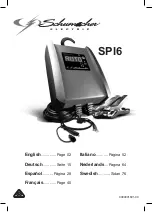
F3 Series Charger Manual
7
The F3 has provision for either local or remote sensing of temperature. Local sensing is done by
components located on the charger’s control board, which is exposed to the ambient air. At installations
where the battery is located in a different room, or is otherwise subject to ambient temperatures different
from the charger it is necessary to sense temperature at the battery. The SENS remote sensor is optional.
The control board automatically selects the remote sensor over the local sensor. If the remote sensor is
damaged or disconnected temperature sensing automatically reverts to local.
The two leads of the RTS are connected to a port on the control board as follows: Connect the yellow lead
of the sensor to J6 “K” and the violet lead to J6 “A”. If the sensor is connected properly D12 will not
illuminate when the charger is in operation. If D12 stays lit, check that RTS leads are not reversed, and
check that the RTS is not damaged. Any excess length of the RTS leads should be cut off rather than
coiled, to ensure the shortest possible length. The RTS leads should be routed separately and away from
all other AC power, DC power, and alarm wires and cables to prevent noise coupling that may cause
abnormal operation of the charger.
NOTE
: D12 on the control board will remain lit whenever the remote temperature sensor is either not
used, or if the remote sensor is disabled. This is normal when RTS is not used.
3
Operation
3.1
Start-up
Start with both input and output breakers OFF.
First, check that the connected battery voltage is correct (e.g. 120 volts for a 120 volt charger). It is OK if
the battery voltage is different from the nominal value by a few percent. If the battery voltage is more
than 10% different from the rated voltage of the charger, recheck your connections BEFORE turning on
either breaker.
Caution: To prevent damage to the charger, ensure the charger is connected to the battery and the load
(not solely the load) prior to closing the DC breaker. The battery should be approximately 3 to 4 times
the charger output current rating (e.g. 100 Amp charger needs 300-400Ah battery bank).
Next close the AC input breaker. Check that the charger voltage comes up to approximately nominal.
(Some voltage overshoot on initial startup is normal).
Next close the DC output breaker. The charger will immediately begin to supply current if required by the
battery or load.
In chargers with alarms code “5” or “6”, the front panel AC FAIL and CHARGE FAIL lights will
extinguish, and should be replaced by the green AC ON light.
The charger will automatically supply power to the load and maintain the battery without further attention.
If the charger does not start as described, or appears to have failed, check the following:
• Verify that AC mains power is available
• Verify that no external circuit breakers are tripped
• Verify that contractor-installed AC, DC and alarm connections are correct
•
Disconnect AC and DC power sources.
Open the charger. Verify that no components (e.g. main DC
output fuse, if fitted) or harness connections are blown, loose or damaged
If all of the above appear to be in order, contact SENS at the toll-free service number on the front of this
document for assistance in troubleshooting.
3.2
FLOAT/BOOST MODES
Two modes of voltage control are provided in all F3 chargers as follows:
FLOAT
The float mode is the battery “maintenance” voltage. It is the normally fully charged voltage of the






































